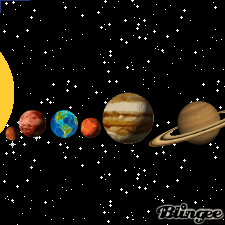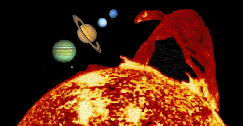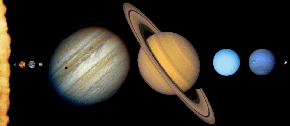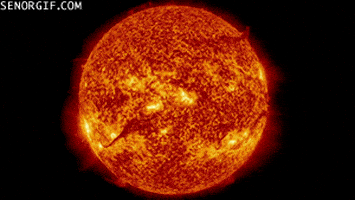
The Origin of the Solar System

The Origin of the Solar System
Scientific textbooks are clearly written, lavishly illustrated, and they carry the full weight of the authors' beliefs and experience. Every generation of eager young students all too eagerly accepts the current scientific theories as gospel truth, not realizing that the text books of a previous generation proclaimed---with the same authority---models of the real world that have now been discarded. Such is the nature of "scientific progress!"
"Science is the only self-correcting human institution, but it is also a process that progresses only by showing itself to be wrong."---Astronomer Allan Sandage.
Theories for the origin of our solar system have come and gone, yet even today no satisfactory model exists that both explains all the facts and is consistent with the known laws of physics.
As science in the western world began to abandon a Judeo-Christian view of creation, beginning about 200 years ago, the trend towards purely naturalistic explanations emerged. Today these views, known as "scientism" constitute the majority state-religion in our public school systems---if God exists at all He is uninvolved and irrelevant to a full understanding of the world we live in. (Ref. 1).
German philosopher Immanuel Kant in 1755 hypothesized the origin of the solar system as beginning with a rotating gaseous nebula out of which condensed globular bodies that became the sun and planets---all revolving in the same direction. (Ref. 2). Essentially the same theory, now called "the nebular hypothesis" was proposed by the French mathematician Laplace in 1796. According to this model the hot rotating gas cloud began to cool and contract, and if this were to happen the law of conservation of angular momentum requires a more rapid rate of rotation. This speed up was supposed to have flung off rings which condensed into the planets.
James Clerk Maxwell and Sir James Jeans refuted the nebular hypothesis a hundred years later by showing that there was insufficient mass in the rings to provide enough gravitational attraction to form planets. Then, astronomer F.R. Moulton of Chicago called to attention the fact that the planets of our solar system carry 99% of the angular momentum of the solar system, while the sun has 99.9% of the total mass. The nebular hypothesis couldn't possibly be correct, else the sun would presently be rotating a hundred times faster than it does now (once every 27 days) in order to conserve and distribute the angular momentum of the system correctly.
Sir James Jeans and Sir Harold Jeffreys then revived a 1749 proposal of Count Buffon known as "the collision hypothesis." A passing star was supposed to have pulled of giant tongues of gaseous matter from the sun. These streamers then presumably broke into small chunks called "planetesimals." But, calculations showed that a passing star would pull off interior gases from the sun as hot as a million degrees Centigrade and these gases would surely disperse into space and not coalesce. Besides, stars are very far apart---the vastness of space makes the close encounters of two stars absurdly rare---in 14 billion years such events would be expected to have happened only once or twice.(Ref. 3).
More recently cold accretionary theories for star and solar system formation have been attempted after the discovery that "empty" space contains considerable hydrogen, helium and dust. The dust resembles terrestrial compounds---silicon compounds, iron oxides, ice crystals, and even some organic molecules. So why not imagine the condensation of a "proto-sun" eventually collapsing under the pull of gravity, heating and eventually igniting in the now-familiar nuclear burning process by which hydrogen is compacted to form helium with the release of vast amounts of energy? The gases of space end up mostly in the sun, somehow, and the dust particles in the terrestrial planets by some kind of wondrous separation mechanism.
Chemist Harold Urey, physicist W.A. Fowler, and astronomer Sir Fred Hoyle attempted to make this model workable by suggesting plasmas and magnetic coupling to explain how the sun's originally high angular momentum was transferred to the planets. Unfortunately there is no reason for molecules of gas and dust in space to stick together, congeal and cluster under the influence of random, disorderly collisions, the extremely weak force of gravity and the inexorable tendency to disorder dictated by the Second Law of Thermodynamics. There are many other problems that remain unsolved mysteries to this day, for example, one would expect as much as a third of the solar systems mass to reside in the planets and there are puzzling special problems with respect to the distribution of the planets, orbital inclinations and with many of the solar system's 34 moons.

Many current textbooks (Ref. 4, 5) these days do assume a "cold accretionary process" for the origin of the earth, as opposed to the hot flaming gaseous atmosphere, molten surfaces and erupting volcanoes of primeval earth depicted in the textbooks of a generation ago. This of course is much closer to what the Apostle Peter tells us about the origin of the earth in his second epistle, in agreement with Genesis 1:1 and Psalm 104:
"...by the word of the Lord heavens were held together long ago, and an earth (formed) out of water and by means of water ..." (Ref. 6).
The fact remains that no satisfactory naturalistic explanation for the solar system has been found. For the benefit of ambitious young scientists who might want to try, any successful theory will need to take into account the following unusual features of our solar system:

Secular science has lost much of its luster in recent years as more and more people have seen that purely materialistic, naturalistic explanations for the origin of the universe and of life are almost all bankrupt. A number of outstanding, competent scientists who are also Christians are calling clear attention these days to the sheer impossibility of a universe coming into existence by time plus chance, by any combination of natural processes, apart from the work of an outside Designer, Architect and Master Craftsman. (Ref. 9). See The Limits of Science.
Genesis One, plainly read, declares that the earth was formed on Day One of creation week and the sun, moon, stars and planets all on Day Four. This notion is considered ludicrous to virtually all of today's secular scientists, yet Genesis is as fully authoritative as any other book of Holy Writ and invariable sound in the long run when addressing subjects that bear on scientific discovery. The authority of Genesis and the rest of the Bible rests on the integrity and authority of Jesus Christ.
So central is the earth in the Biblical model of creation that intriguing models of Geocentricity are still proposed by some competent scientists who take Genesis seriously (Ref. 10). Of course it is difficult to make a convincing case for earth being at the center of the physical universe based solely on modern astronomy. But as far as theology is concerned, earth is the one unique planet where the Son of God chose to become a man. Earth was where He chose to redeem mankind by His death on a cross. In that cross he "reconciled all things to himself" (Col. 1:19, 20)---thereby undoing evil not only on earth but also everywhere else it may exist in the cosmos and among the angels. The account of creation given in Genesis One very much suggests the observer is a man standing on the earth while the events of creation week are taking place. Finally the Son of God has chosen to reign from Jerusalem over a restored earth and from the satellite city, New Jerusalem, over an entirely renewed creation---new heavens and a new earth.
The Biblical view of the universe is that it consists of a physical, material world and an unseen but very real spiritual world. The spiritual realm is commonly referred to as "the heavenlies" in the Bible---the Bible does not use the term "supernatural." The heavenlies are inhabited by "heavenly hosts," that is by angels. From the New Testament letter to the Hebrews we learn that the physical creation, which we see and touch has its source in unseen, invisible things:
"Now faith is the assurance (hupostasis = "to stand under", i.e., support, foundation) of things not seen. For by faith the men of old gained divine approval. By faith we understand that the world (aionos = ages, or world) was created (katartizo = to fit, or render complete) by the word (rhemati = the oracles, sayings, or spoken utterances) of God, so that what is seen came into being out of that which is unseen." (Hebrews 11:3)
The physical world, the material realm, is perfectly real and solid (not maya, or illusion, as Hinduism supposes), but it is the world of the fading, the transitory, the impermanent, and the perishable. The Biblical view is in some ways similar to the Greek (Platonic) idea of invisible ideas and archetypes which produces resulting forms in the physical world. But there are important differences of course between the Greek and Hebrew world-views. The entire creation we live in is spoken of in the Bible as the "old creation," which of course contrasts that creation with a later "new creation." Something has gone wrong in the old creation producing death and decay, corruption and disintegration. The old creation is now a ruined creation. Evil has disturbed our universe, interfering with both the realm of the spirit and realm of the physical---which includes disruptions in the laws of physics which have taken place since the Seventh Day of God's work in creation. Evil in the universe has damaged the original close and harmonious coupling between the spiritual and material dimensions of existence. What we now see and observe and experience is not the creation as it was finished at the end of the sixth day, but an aging, dying creation. When any one of us chooses to know God through faith in Jesus His Son, God responds by making us members of a new human race, headed by His Son, Jesus, the Last Adam. He has prepared a place for us to live in forever-a new creation:
"So we do not lose heart. Though our outer nature is wasting away, our inner nature is being renewed every day. For this slight momentary affliction is preparing for us an eternal weight of glory beyond all comparison, because we look not to the things that are seen but to the things that are unseen; for the things that are seen are transient, but the things that are unseen are eternal." (2 Corinthians 5:6-8)
Even if we succeed in mapping the physical universe, we are at a loss when it comes to measuring coordinates of time and space in the heavenly realm. The spiritual world is another dimension of reality (not a mere extension of the physical world into more than four dimensions). The spiritual world permeates the physical world and that means that "heaven" is all around us and within us---not far away beyond the most remote galaxy at the edge of space. See Time and Eternity
According to Genesis, God first created space, time and matter on the First Day. Then He created light (energy). These four, basic, constituent "elements" were then used to construct a universe. The physical universe was molded, formed fashioned and filled during six days. The earth was formed in the midst of the primal waters on the First Day---the sun, moon and stars were not fashioned until Day Four. Those who suggest otherwise must force Biblical interpretation well beyond all reasonable bounds (Ref. 11). Creation week was a unique, never-to-be-repeated sequence of events during which "time" the ordinary laws of physics as we know them now were suspended. Only when God's creative work was finished was the universe set in motion as a dynamical system. How God does things almost always escapes our ability to discover (Ref. 12). This is especially true of creation week-naturalistic explanations for the solar system can't even begin to retrace God's artisanship in creation. See especially The Uniqueness of Creation Week.
Catastrophes affecting the creation evidently occurred some time after the end of creation week---but not before because of the statement of Genesis 1:31---the older "gap theory" proposing a catastrophe between Gen. 1:1 and 1:2 has been well refuted by Hebrew scholars in recent years. Disasters affecting the solar system could have occurred in connection with the fall of the angels, or could be related somehow to the fall of man and the resultant "curse" on the earth. The Second Law of Thermodynamics and radioactive decay were probably not operative in the universe until after the fall. The angels have a role in the government of nature (Heb. 2:5), so the fall of one third of God's angels may have had major consequences in the way nature has operated ever since. See The Ruin of Creation
In a subsequent article we will examine the geologic history of the earth and show how early core meltdown, the Flood of Noah and continental drift may have been set in motion by disruptions in nature associated with the fall of man and the angels. Catastrophism is now back in vogue in secular science, and a biblical world-view certainly makes rooms for disasters. See Questions Concerning the Early History of the Earth.

In reconsidering the creation of the earth, the solar system and the rest of the vast universe a good place to begin is to reflect in awe with the Psalmist of old who penned this words as inspired by the Holy Spirit:

Psalm 104
Note: Verse 6 is not referring to the Flood of Noah, but refers to the formation of the earth out of water during creation week, Gen. 1:9-10, Ps. 36:6, 2 Peter 3:5. Not all Bible scholars agree with me on this point, but most all creationist scholars do.

1. Ian T. Taylor, In the Minds of Men: Darwin and the New World Order, TFE Publishing, PO Box 1344 Stn F. Toronto M4Y 2T1, Canada, 1991.
Concerning the widespread secular philosophy Ray C. Stedman says the following:
Humanism teaches that:
2. Frank Press and Raymond Siever, Earth, W. H. Freeman, San Francisco, 1974.
3. Robert Jastrow and Malcolm H. Thompson, Astronomy: Fundamentals and Frontiers, John Wiley and Sons, New York, 1977.
4. Robert H. Dott, Jr., Roger L. Batten, and Randall D. Sale, Evolution of the Earth, McGraw-Hill, New York, 1971.
5. Roman Smoluchowski, The Solar System. Scientific American Library, New York, 1983.
6. 2 Peter 3:5
7. Tom Van Flandern, Dark Matter, Missing Planets, and New Comets: Paradoxes Resolved, Origins Illuminated, North Atlantic Books, Berkeley 1993.
8. John C. Whitcomb, Jr., The Origin of the Solar System, Baker Book House, Grand Rapids, 1963.
9. J.P. Moreland, Ed., The Creation Hypothesis: Scientific Evidence for an Intelligent Designer, Intervarsity Press, Downers Grove, IL, 1994.
10. Gerardus D. Bouw, PhD., Geocentricity, Association for Biblical Astronomy, Cleveland, 1992.
11. James Stambaugh, Star Formation and Genesis 1 Impact #251, May 1994, Institute for Creation Research, El Cajon, CA.
12. "...How unsearchable are God's judgments and his ways beyond finding out." (Romans 11:33).
May 14, 1994. July 20, 2020.
Addendum: Added January 31, 2008. This paper is now very outdated! I am much more inclined nowadays to subscribe to a plasma model for the origin of the galaxies, the stars and planets. (I have not changed my views of God's involvement in all aspects of creation).
The Electric Universe. Gravity is by far the weakest of the four basic forces, whereas electric and magnetic forces are much much greater.

Please see Barry Setterfield's Introduction to a Plasma Cosmology
 lambert@ldolphin.org
lambert@ldolphin.org
I send out periodic Bible-study newsletters. They are archived on my web site.
Web Pages: Lambert's Library